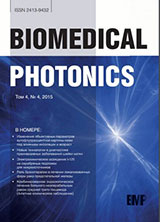
Scientific and practical reviewed journal
The «Biomedical Photonics» journal is an effective professionally-oriented content for publication of results of the latest studies in the field of biomedical photonics, sharing experiences and discussion between specialists.
The main goal of the journal is to highlight the latest results of scientific and practical (clinical and experimental) activities in the field of fluorescence diagnostics and photodynamic therapy, as well as other areas of laser medicine. An important task is to create a single all-Russian platform for integrating the knowledge and experience of scientists and practitioners in this field.
Currently the «Biomedical Photonics» journal - popular venerable publication directed towards wide range of specialists in laser medicine including practitioners, researchers (health professionals, biologists, physicists, chemists), developers of agents for laser medicine and manufacturers of laser medical devices.
State of the art reviews which highlight current status of experimental and clinical studies in the field of laser medicine are published in the journal on a regular basis. The majority of published articles represent the result of certain biological and medical (including clinical) trials. Some articles are related to studies of action of different types of laser on biological tissues and objects, to search and investigation of properties of novel drugs including photosensitizers for fluorescence diagnosis and photodynamic therapy, to development of new laser equipment. The most interesting case-reports and medical technologies are also published in the journal, news about professional association’s activities (information about scheduled and accomplished research and training conferences and workshops, about educational programs, memorable dates and anniversaries of prominent specialists in biomedical photonics) are represented, materials of annual international congress “Topical issues of photodynamic therapy and photodiagnosis” are announced.
Four issues are published annually. The journal is always open to new ideas, creating a wide research and discussing platform for professionals.



































